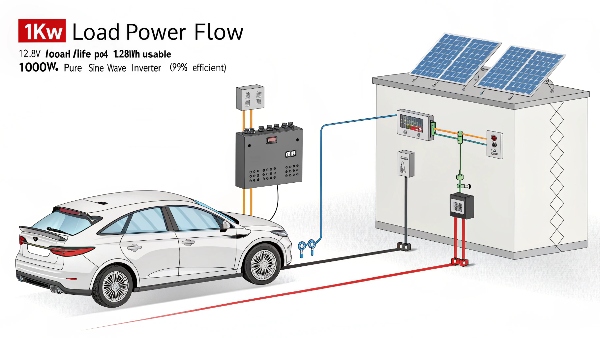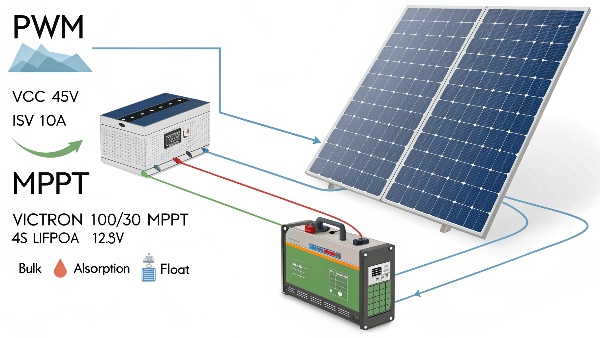Power outages can be frustrating. Worried if your solar system has enough backup power? Let's examine if a 100Ah LiFePO4 battery can handle a 1kW inverter.
Yes, a 100Ah LiFePO4 battery can run a 1kW solar inverter for about 1 hour at full load. LiFePO4 batteries typically allow 100% depth of discharge, providing the full 1.2kWh capacity needed.

Solar power systems are becoming increasingly popular as more people seek reliable, clean energy. The combination of LiFePO4 batteries and solar inverters creates an excellent solution. Let's understand how this setup works and what factors affect performance.
Can you charge a lithium battery with a solar panel?
Want to harness solar power but unsure how to store it? Charging batteries with solar panels seems complex. Here's how it actually works.
Yes, you can directly charge a lithium battery with a solar panel using a solar charge controller. The controller regulates voltage to safely charge the battery while preventing overcharging.

Using solar panels to charge lithium batteries like LiFePO4 is straightforward with the right components. Here's how it works:
Components Needed:
- Solar Panel
- Charge Controller (MPPT is best for lithium batteries)
- Lithium Battery Bank
- Inverter (to convert DC to AC power)
Key Considerations:
- The charge controller must be compatible with lithium battery chemistry
- Solar panel output should match battery charging requirements
- System voltage (12V/24V/48V) must be consistent across components
- Battery capacity should align with your energy needs
At Daopulse, we see growing demand for solar-compatible LiFePO4 home energy storage systems. Our 12 years of OEM/ODM experience helps brands create reliable solar storage solutions.
Are there inverters that can't charge a LiFePO4 battery?
Some inverters seem to cause battery issues. Are all inverters safe for your lithium battery? Here's what you need to know.
Yes, some older or basic inverters may not properly support LiFePO4 battery charging. You need an inverter with lithium-compatible charging profiles or a separate lithium-specifc charge controller.
Comparison of compatible and incompatible inverters for LiFePO4
Not all inverters work equally well with lithium batteries. Here are the key differences:
Inverter Types and Compatibility:
| Inverter Type | Lithium Battery Support | Notes |
|---|---|---|
| Basic Modified Sine Wave | Limited | May lack proper charging algorithms |
| Pure Sine Wave | Sometimes | Check manufacturer specifications |
| Hybrid Inverter | Usually | Often includes lithium charging profiles |
| Solar-Specific Inverter | Best | Designed for renewable energy systems |
Key points:
- Many new inverters include selectable battery types
- Some allow custom charging parameters
- Always verify compatibility before purchase
Our OEM/ODM clients often specify inverter requirements when ordering lithium battery systems, ensuring seamless integration with solar installations.
How many 32650 lithium batteries in a 100w solar panel?
Solar system planning can be confusing. How does battery quantity relate to solar panel size? Let's break it down.
The number of 32650 batteries depends on system voltage. For example, a 12V system requires 4 batteries in series (3.2V × 4 = 12.8V). But the total parallel banks depend on your energy storage needs.
Array of 32650 lithium batteries connected in series and parallel
Understanding battery configurations helps design efficient solar systems:
Battery Setup Guidelines:
- Determine system voltage (common: 12V, 24V, 48V)
- Calculate series connections:
- Each 32650 LiFePO4 cell = 3.2V nominal
- 12V system: 4 cells in series (3.2V × 4 = 12.8V)
- Estimate parallel connections based on:
- Desired capacity (Ah)
- Each cell's capacity (typically 5-6Ah)
- Match to solar panel output:
- 100W panel = ~5-8A at 12V
- Charge time depends on battery bank size
Example for 100Ah 12V system:
- 4 cells in series × 20 parallel groups (using 80 cells total)
- 5Ah per cell × 20 = 100Ah capacity
Why use lithium batteries for solar energy storage?
With multiple battery options available, why choose lithium? Here's why lithium batteries dominate solar applications.
Lithium batteries outperform alternatives for solar storage with longer lifespan (2000-5000 cycles), higher efficiency (95-98%), lightweight, and better depth of discharge (80-100%) compared to lead-acid batteries (50% DoD, 300-500 cycles).
"Before and after" comparison showing space savings of lithium vs lead-acid
Lithium batteries offer several advantages that make them ideal for solar energy storage:
Key Benefits:
- High Efficiency: More usable energy from each charge
- Long Lifespan: Lasts 4-10× longer than lead-acid
- Compact Size: Requires less installation space
- Low Maintenance: No watering or equalization charging
- Better Performance: Works well in varied temperatures
Additional advantages:
- Faster charging capability
- More flexible installation options
- Better state-of-charge accuracy
- Safer chemistry (especially LiFePO4)
At Daopulse, we've worked with numerous brands along the Belt and Road to implement lithium solar storage solutions. The market clearly prefers lithium chemistry for modern solar applications.
Conclusion
A 100Ah LiFePO4 battery can power a 1kW inverter for about an hour. Lithium batteries offer the best solution for growing solar energy storage needs.

